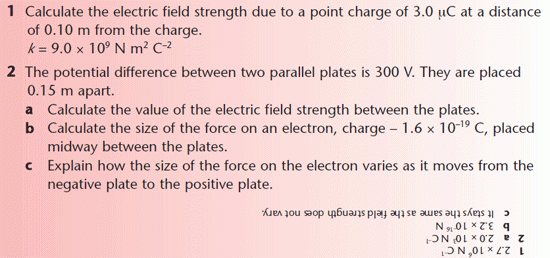Electric fields
After studying this section you should be able to:
- describe the electric field due to a point charge and between two charged parallel plates
- calculate the force on a charge in an electric field
- compare gravitational and electric fields
This section covers
- Charging Up
- The Electric Field
- Field Strength
- Potential
- Potential in a Radial Field
- Electron Beams
- Deflecting a Beam of Electrons
- Comparing Electric and Gravitational Fields
Charging up
Transfer of charge happens whenever two objects in physical contact move relative to each other. It is caused by electrons leaving one surface and joining another. This results in objects having one of two types of charge:
- an object that gains electrons has a negative charge
- an object that loses electrons has a positive charge.
Electrostatic phenomena such as attraction and repulsion are due to the forces between two charged objects. Similar charges repel and opposite charges attract.
In many cases any imbalance of charge on an object is removed by movement of electrons to and from the ground, but if at least one of the objects is a good insulator charge can build up.
A balloon is easily charged by rubbing but it is not possible to charge a hand-held metal rod since it is immediately discharged by electrons passing through the person holding it.
The quantum, or smallest unit, of charge is that carried by an electron. All quantities of charge must be a whole number multiple of e = – 1.6 × 10–19 C.
The electric field
Unlike gravitational fields, which can only exert attractive forces, electric fields can attract or repel objects that are charged. When drawing field lines that represent the forces due to a charged object, the arrows show the direction of the force on a positive charge.
The diagram shows the electric fields due to a point charge and between a pair of oppositely charged parallel plates.
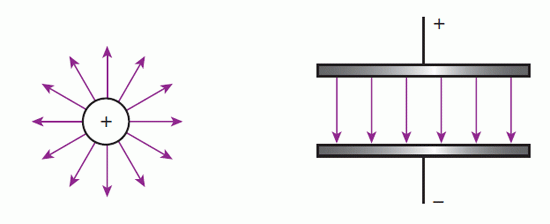
A pair of parallel plates become oppositely charged when connected to the positive and negative terminals of a d.c. supply.
The field due to the point charge is radial, it decreases in strength with increasing distance from the charge. That between the parallel plates is uniform, it maintains a constant strength at all points between the plates.
Coulomb investigated the size of the force between two point charges and concluded that the force is:
- proportional to each of the charges
- inversely proportional to the square of their distances apart.

Permittivity is a measure of the extent to which the medium reinforces the electric field. Water has a high permittivity due to its molecules being polarised.
Field Strength
Electric field strength:
- is defined as the force per unit positive charge acting on a small charge placed within the field
- is measured in N C–1
The test charge has to be small enough to have no effect on the field.
Coulomb’s law can be used to express the field strength due to a point charge Q. Since the force between a charge Q and a small charge q placed with the field of Q is given by
, it follows that:
KEY POINT - The electric field strength, E, due to a point charge Q is given by the expression:

In a radial field, the field strength follows an inverse square law. This can be seen by the way in which the field lines spread out from a point charge. In a uniform field, like the one between two oppositely charged parallel plates, the field lines maintain a constant separation. The value of the electric field strength in a uniform field does not change.
KEY POINT - The electric field strength between two oppositely charged parallel plates is given by the expression:
where V is the potential difference between the plates and d is the separation of the plates.
This gives an alternative unit for electric field strength, V m–1, which is equivalent to the N C–1.
Potential
The potential difference between the parallel plates represents the energy transfer per coulomb when charge moves between
them. A charge q moving between the plates would gain or lose energy Vq.
In a uniform field the potential changes by equal amounts for equal changes in distance. The diagram here shows the variation in potential between two oppositely charged plates.
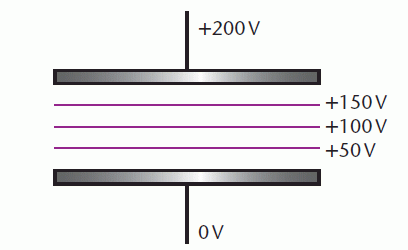
In this example:
- potential has been measured relative to the lower plate, which has been given the value 0
- the equipotential lines are parallel to the plates
- an equipotential surface, joining points all at the same potential, is simply a surface drawn parallel to the plates.
Potential could be measured relative to the upper plate, in which case the potentials would have negative values.
Potential in a radial field
Like potential in a gravitational field, absolute potential in an electric field is
measured relative to infinity. Infinity does not need to be a great distance, since it
refers to a point where the field strength is negligibly small.
KEY POINT - The electric potential at a point, V, is the work done per unit positive charge in bringing a small charge from infinity to that point. In a radial field,

Unlike the potential in the gravitational field of a point mass, the electric potential in the field of a point charge is positive, since work has to be done to move a positive charge from infinity to any point in the field.
Electron beams
Computer monitors, televisions and cathode ray oscilloscopes all use beams of electrons to produce a picture. The beam is produced by an electron gun, a device that accelerates and focuses the electrons given off by a hot wire. The diagram below shows an electron gun.
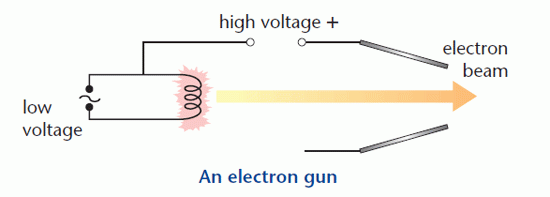
The low voltage supply heats the filament, causing it to emit electrons. The electrons are accelerated by the high voltage supply, gaining kinetic energy as they move towards the positively charged anode. Since the potential difference between the cathode and the anode represents the energy transfer per coulomb of charge, the kinetic energy of the accelerated electrons can be calculated.
The filament is the cathode, or negative terminal. The anode is usually cylindrical and is connected to the positive terminal of the high voltage supply.
KEY POINT - When an electron is accelerated through a potential difference V it gains kinetic energy

where me is the mass of an electron and e is the electronic charge.
Deflecting a beam of electrons
In a cathode ray oscilloscope, vertical deflection of the electron beam is achieved by passing the beam between a pair of oppositely charged parallel plates. The effect of this can be seen by studying the path of a beam of electrons in a deflection tube.
When passing between the plates, the electrons have a constant speed in the direction parallel to the plates. Perpendicular to the plates, the force on each electron is equal to Ee, so they accelerate in this direction. The consequent motion of the electrons is similar to that of a particle projected horizontally on the Earth; in each case the result is a parabolic path, shown in the diagram.
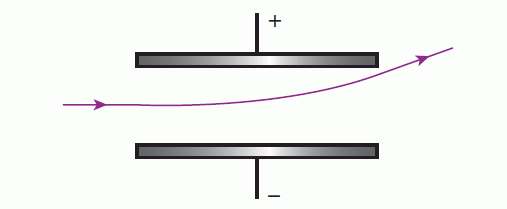
The path of the electrons before entering the field and after leaving the field is a straight line as there is no resultant force acting on them.
When moving between the plates:
- the electrons travel equal distances in successive equal time intervals in the direction parallel to the plates
- the electrons travel increasing distances in successive equal time intervals in the direction perpendicular to the plates.
Comparing electric and gravitational fields
There are similarities and differences between electric and gravitational fields:
- electric field strength is defined as force per unit charge, gravitational field strength is defined as force per unit mass
- electric potential and gravitational potential are defined in similar ways
- the electric field due to a point charge is similar to the gravitational field of a point mass
- electric fields can attract or repel charged objects, gravitational fields can only attract masses.
PROGRESS CHECK
